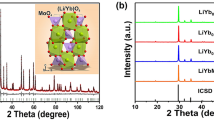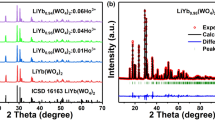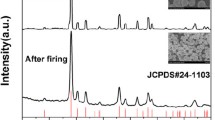Abstract
The possibility of combustion synthesized Ho3+–Tm3+–Yb3+ codoped Y2O3 phosphor as temperature sensor using fluorescence intensity ratio (FIR) technique under a 980 nm excitation has been reported. The variation in FIR of blue upconversion emissions generated from two closely spaced levels of the Tm3+ and Ho3+ ions (1G4 and 5F3) as a function of temperature has been monitored up to 703 K. The maximum relative sensitivity has been found to be 3.38 × 10−3 K−1 which indicates that the present phosphor material can play a vital role for high optical thermometric purpose. The results imply that the FIR of two closely spaced levels of two different rare earth ions can also be used as temperature sensor.
Similar content being viewed by others
Avoid common mistakes on your manuscript.
1 Introduction
Optical temperature sensors are the sensitive tools which are based on the emission intensity changes with change in temperature where the conventional sensors cannot be used. The developments of temperature sensors have attracted much attention among researchers due to its wide applications in diverse fields such as electrical power stations, building fire detection, diagnosis of diseases, oil refineries, air craft, coal mines [1–3]. The study of optical temperature sensors is based on two methods, namely fluorescence intensity ratio (FIR) and fluorescence lifetimes (FL) techniques. The FIR technique is valuable and noncontact method because it reduces the emission loss as well as the fluctuations in pumping intensity and can measure the temperature at a distance from the object. This technique is used to improve the sensitivity of measurement and minimize the influence of measurement conditions [4, 5]. The FL technique is not suitable for high-temperature measurements, while FIR technique suits very well [6, 7]. In FIR technique, the ratio of emission intensity arising from two closely spaced levels of one or more rare earth ions is used. Rare earth ions doped materials are commonly used as sensing medium due to its special character [3, 8, 9]. Several rare earths doped materials have been investigated as temperature sensor by using the FIR of two closely spaced levels of single ions [6–20]. But the FIR of two closely spaced levels of different ions doped simultaneously has been used for temperature sensing purpose very rarely [21]. In recent years for the miniaturization of the sensing equipments, it is essential to refocus on nano-sized solid hosts having its optical properties mostly different from their bulk counter parts.
In the present work, we have investigated the temperature-dependent blue upconversion (UC) emissions from the combustion synthesized Y2O3:Ho3+–Tm3+–Yb3+ phosphor upon near infrared (NIR) excitation from a diode laser using FIR of the 1G4 → 3H6 and 5F3 → 5I8 transitions of Tm3+ and Ho3+ ions, respectively. The possibility of obtaining a good temperature sensor for higher temperature range with better sensitivity using two different rare earth ions has been explored.
2 Experimental
The materials of high purity (99.90–99.99 %) have been used for synthesis of the Y2O3:Ho3+–Tm3+–Yb3+ phosphor by combustion process using Y2O3, Ho2O3, Tm2O3 and Yb2O3 as raw materials and urea as the organic fuel. The composition of compounds used was (100–x–y–z) Y2O3 + x Ho2O3 + y Tm2O3 + z Yb2 O3, where x and y were fixed at 0.1 mol % and z varied from 1.0 to 7.0 mol %. The desired amounts of these materials were first dissolved in nitric acid properly to get the transparent solution. The transparent solution was then mixed with urea and stirred at 1,000 rpm with the help of magnetic stirrer heated at 353 K. In one to two hours, the solution became a transparent gel and was then rapidly heated in a furnace preheated at 923 K. Within 4 minutes, the solution becomes foamed and a flame was produced which lasted in few seconds. After that, the sample was immediately removed from the furnace and the resultant fluffy mass was taken out. The fluffy mass of samples was grinded into fine powder form and finally, the Y2O3:Ho3+–Tm3+–Yb3+ phosphor powders were used for further characterization purposes.
The determination of crystal structure and average crystallite size of the developed phosphor has been performed by using X-ray powder diffraction pattern recorded by an X-ray diffractometer using Cu Kα1 radiation (λ = 0.154 nm) in the 10–80° range. The UC emission spectra have been recorded using a Princeton triple grating monochromator (Acton SP-2300) attached with a photomultiplier tube (PMT) and personal computer (PC). The samples were irradiated by a diode (CW) laser of spot size 1.4 mm operating at 980 nm. For the temperature measurements, the sample was placed in a homemade small furnace and heated to temperatures within the 303–703 K range and measured with the help of a thermocouple located closer to the sample.
3 Results and discussion
The X-ray diffraction (XRD) pattern of as-synthesized Y2O3:Ho3+–Tm3+–Yb3+ phosphor prepared by combustion route shows that the sample is well crystallized, cubic shaped with the lattice parameters a = b = c = 10.604 Å and α = β = γ = 90°. The average crystallite size ~ 43 ± 4.0 nm of synthesized phosphor has been calculated by using the Debye–Scherrer’s formula. The sharp and intense diffraction lines show the good powder crystallinity, and the detailed explanation about the XRD analysis is given in our previous report [22].
The blue UC emission spectra of optimized Y2O3:Ho3+–Tm3+–Yb3+ phosphor in the wavelength range 450–510 nm upon a 980 nm diode laser excitation on increasing the sample temperature at an excitation power of 250 mW are shown in Fig. 1. There appears two intense peaks around 477 and 488 nm corresponding to the 1G4 → 3H6 (Tm3+) and 5F3 → 5I8 (Ho3+) transitions, respectively.
Along with the blue emissions around 477 and 488 nm, the other UC emissions are also observed. The detail of the transitions observed and the processes responsible for these UC emissions are reported elsewhere [22]. The blue UC emissions observed in the present material are caused by the absorption of two photons. A simplified energy level diagram of the Ho3+–Tm3+–Yb3+ ions for blue UC emission is shown in Fig. 2. A pair of the Yb3+ ions in its excited (2F5/2) state transfer its excitation energy cooperatively [i.e., through cooperative energy transfer (CET)] to the Ho3+ and Tm3+ ions and excites them to the 5F3 (Ho3+) and 1G4 (Tm3+) states, respectively. The excited ions in these states relax radiatively to the ground states giving blue emissions corresponding to the 5F3 → 5I8 (Ho3+) and 1G4 → 3H6 (Tm3+) transitions.
As the 1G4 and 5F3 states of the Tm3+ and Ho3+ ions are very close to each other (∆E = 473 cm−1), a small change in the environmental condition may change the emission intensity caused by the change in population of the state. The emission intensity arising from a particular level depends on a number of parameters viz. the energy level of interest, host material, the excitation method utilized. On increasing the sample temperature, the peak positions of blue emissions corresponding to the 1G4 → 3H6 (Tm3+) and 5F3 → 5I8 (Ho3+) transitions do not change while the overall intensities of bands decrease (Fig. 1). But, the change in emission intensity for both transitions with increasing the sample temperature is different. The intensity of emission corresponding to the 1G4 → 3H6 (Tm3+) transition enhances compared to that of the 5F3 → 5I8 (Ho3+) transition and becomes significant at higher temperatures. At low temperature (303 K), the intensity of the 1G4 → 3H6 transition is very small in comparison with the 5F3 → 5I8 transition, and at slightly higher temperature (403 K), the intensity of both transitions becomes equal. At higher temperatures (>403–703 K), the intensity of the 1G4 → 3H6 transition becomes larger than that of the 5F3 → 5I8 transition. The thermally induced changes in the emission intensity generally arise from the temperature dependence of nonradiative decay rates of energy levels.
The relative population of two closely spaced levels 1G4 and 5F3 follows a Boltzmann-type population distribution [2]. Therefore, the temperature-dependent intensity ratio of emissions corresponding to both transitions can provide an idea for determining the temperature. Ignoring the effect of self-absorption, the FIR of blue UC emissions originating around 477 and 488 nm with temperature may be expressed as [2, 12]
where I477 and I488 are the integrated intensities corresponding to the 1G4 → 3H6 and 5F3 → 5I8 transitions, respectively. R is the symbol to represent FIR and ∆E is the energy gap between the 1G4 and 5F3 levels. T is the absolute temperature and k is Boltzmann’s constant. The pre-exponential factor B is a constant.
The variation of logarithmic of FIR as a function of the inverse absolute temperature is shown in Fig. 3.
Figure 3 gives a linear variation and the slope of the fitted straight line corresponds to ∆E/k. The experimental data were fitted by a straight line whose slope was found to be 638.5 ± 11.1 with intercept about 1.37 ± 0.25. This gives the energy gap (∆E) between the two emitting (1G4 and 5F3) levels as 443.82 ± 7.72 cm−1, which is in good agreement with the actual energy gap (∆E = 473 cm−1) between the two levels. The value of coefficient B was calculated to be ~3.93. Thus, from Eq.(1), one can notice that if the FIR of two close lying levels at different temperatures is known then their intensity ratio can be used to measure the temperature. The observed and calculated values of the temperatures using thermocouple and FIR of two close lying levels 1G4 and 5F3 around 477 and 488 nm are plotted together (Fig. 4). The observed and calculated values of the temperature are in good agreement within the given temperature range.
The accuracy of temperature sensor can be determined on the basis of error in measured temperature and estimated by the formula [3, 9]
where ∆T is the error in measured temperature and ∆R is change in FIR. The error in measured temperature is found to be ±5.91 K that presents the good accuracy of synthesized phosphor material for thermometric purposes.
For temperature sensing purposes, it is important to know the rate of change of FIR with change in temperature, known as sensitivity (or absolute sensitivity), is defined by the relation [2, 3, 7, 10, 12, 23]
where S is the sensitivity and other terms are explained before. Figure 5 shows the variation of sensitivity with increasing sample temperature. The maximum sensitivity was noted to be 6.96 × 10−3 K−1 at 303 K temperature for the present case.
For optical thermometry, it is also required to determine the sensor sensitivity (or relative sensitivity) that can be written as follows [8, 13–15, 17, 23, 24]
where S R is the sensor sensitivity and other parameters have their usual meanings. A plot of the relative sensitivity as a function of temperature is shown in Fig. 6. At initial temperature 303 K, the relative sensitivity was found to be maximum 3.38 × 10−3 K−1 and minimum about 2.14 × 10−3 K−1 at 703 K. On comparison from the Table 1, the sensor sensitivity and temperature range of the present phosphor material seem to be extremely well with other reported rare earth ions doped materials [10, 12, 16, 21, 23–25], whereas the temperature range in some other reported materials [14, 17] appears to be reasonably good but with poor sensitivity. Therefore, the present phosphor can be a promising material to be used in making the high optical temperature sensor.
4 Conclusions
The optical thermometry through blue UC emissions generated from two closely spaced levels of the Tm3+ and Ho3+ ions (1G4 and 5F3) of combustion synthesized Ho3+–Tm3+–Yb3+ codoped Y2O3 phosphor using FIR technique in 303–703 K temperature range has been presented. The observed and calculated value of the temperature using FIR of two close lying levels at 477 and 488 nm wavelengths has been found satisfactory up to higher temperature with estimated error ±5.91 K. The maximum sensitivity and relative sensitivity 6.96 × 10−3 K−1 and 3.38 × 10−3 K−1 have been determined at 303 K temperature, respectively. The above result shows that the Ho3+–Tm3+–Yb3+ codoped Y2O3 phosphor is a better choice for making high optical temperature sensors.
References
C.F. Valdivielso, E. Egozkue, I.R. Matias, F.J. Arregui, C. Bariain, Sens. Actuators B 91, 231 (2003)
S.A. Wade, S.F. Collins, G.W. Baxter, J. Appl. Phys. 94, 4743 (2003)
V.K. Rai, Appl. Phys. B 88, 297 (2007)
P. Haro-Gonzalez, S.F. Leon-Luis, S. Gonzalez-Perz, I.R. Martin, Mater. Res. Bull. 46, 1051 (2011)
N. Ishiwada, T. Ueda, T. Yokomori, J. Bio. Chem. 26, 381 (2011)
V.K. Rai, C.B. de Araugo, Spectrochim. Acta A 71, 116 (2008)
V.K. Rai, S.B. Rai, Appl. Phys. B 87, 323 (2007)
S.K. Singh, K. Kumar, S.B. Rai, Sens. Actuators A 149, 16 (2009)
W. Xu, X. Gao, L. Zheng, P. Wang, Z. Zhang, W. Cao, Appl. Phys. Express 5, 072201 (2012)
V.K. Rai, A. Rai, Appl. Phys. B 86, 333 (2007)
V.K. Rai, D.K. Rai, S.B. Rai, Sens. Actuators A 128, 14 (2006)
V.K. Rai, C.B. de Araugo, Spectrochim. Acta A 69, 509 (2008)
B. Dong, T. Yang, M.K. Lei, Sens. Actuators B 123, 667 (2007)
C. Li, B. Dong, S. Li, C. Song, Chem. Phys. Lett. 443, 426 (2007)
C. Li, S. Li, B. Dong, Z. Liu, C. Song, Q. Yu, Sens. Actuators B 134, 313 (2008)
A.K. Singh, Sens. Actuators A 136, 173 (2007)
N. Rakov, L.R.A. Bispo, G.S. Maciel, Opt. Commun. 285, 1882 (2012)
P.H. Gonzalez, L.M. Maestro, M. Trevisani, S. Polizzi, D. Jaque, J.G. Sole, M. Bettinelli, J. Appl. Phys. 112, 054702 (2012)
V.K. Rai, A. Pandey, R. Dey, J. Appl. Phys. 113, 083104 (2013)
D. Jaque, L.M. Maestro, E. Escudero, E.M. Rodriguez, J.A. Capobianco, F. Vetrone, A.J. de la Fuente, F.S. Rodriguez, M.C.I. de la Cruz, C. Jacinto, U. Rocha, J.G. Sole, J. Lumin. 133, 249 (2013)
G. Tripathi, V.K. Rai, S.B. Rai, Appl. Phys. B 84, 459 (2006)
A. Pandey, V.K. Rai, Appl. Phys. B 109, 611 (2012)
W. Xu, X. Gao, L. Zheng, Z. Zhang, W. Cao, Opt. Express 20, 18127 (2012)
P. Haro-Gonzalez, I.R. Martin, L.L. Martin, F.S. Leon-Luis, C. Perez-Rodriguez, V. Lavin, Opt. Mater. 33, 742 (2011)
R.K. Verma, S.B. Rai, J. Quant. Spectrosc. Ra. 113, 1594 (2012)
Acknowledgments
Authors are grateful to the University Grants Commission, New Delhi, India, for providing the financial assistance [F. No. 39-534/2010(SR)].
Author information
Authors and Affiliations
Corresponding author
Rights and permissions
About this article
Cite this article
Pandey, A., Rai, V.K. Optical thermometry using FIR of two close lying levels of different ions in Y2O3:Ho3+–Tm3+–Yb3+ phosphor. Appl. Phys. B 113, 221–225 (2013). https://doi.org/10.1007/s00340-013-5460-z
Received:
Accepted:
Published:
Issue Date:
DOI: https://doi.org/10.1007/s00340-013-5460-z










